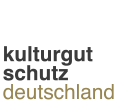Database of cultural property of national significance
The task of protecting cultural property poses a number of challenges; one of the most central of these relates to the question of which cultural property should be placed under special legal protection. Since 1919, Germany has responded to this challenge by operating a register-based system under which special protection status is conferred upon the cultural property of particular significance for Germany that is listed in these registers. Although the entries contained in these registers (currently maintained by the Länder) have altered over the past 100 years, the basic system of individual lists continues in its previous form. The database of cultural property of national significance contains entries for all of the cultural objects included in one of the registers of cultural property of national significance maintained by the Länder.
The term “cultural property of national significance” thus refers to all cultural objects to be entered into the registers of cultural property of national significance. By way of contrast, the umbrella term “national cultural property” that was introduced by the German Act on the Protection of Cultural Property (Kulturgutschutzgesetz, KGSG) reflects the terminology used in EU and international law.
“National cultural property” as an umbrella term (expanded protection of cultural property since August 2016)
According to the Act on the Protection of Cultural Property, all objects belonging to the collections of publicly funded institutions responsible for preserving cultural property are granted general protection as cultural property of national significance (Section 6 (1) (1) to (4) KGSG), which means that a special protection status is conferred upon them even if they have not been entered individually in a register of cultural property of national significance. “National cultural property” comprises two different categories: the cultural property “of national significance” listed in these registers and the collections held by publicly financed institutions responsible for preserving cultural property.
 "Eisgang" von Max Beckmann, 1923.
Source: Städel Museum, Frankfurt am Main
"Eisgang" von Max Beckmann, 1923.
Source: Städel Museum, Frankfurt am Main
All cultural property “of national significance” is therefore also “national cultural property”, but the reverse does not necessarily hold true; this is significant as regards certain provisions of the Act that explicitly relate only to cultural property “of national significance”.
If the standard status of “national” cultural property is conferred upon a cultural object, the latter is eligible for the expanded protection mechanisms under EU and international law that apply to cultural objects granted special protection under national law. Both Directive 2014/60/EU on the return of cultural objects and the 1970 UNESCO Convention grant far-reaching rights to initiate return proceedings in respect of cultural objects that have been unlawfully exported from a Member State or signatory state respectively, provided that the object in question has been granted the status of specially protected “national” cultural property in the relevant country. For example, this means that the Federal Republic of Germany, acting on the owner’s behalf, has 75 years to initiate return proceedings under public law in another country, irrespective of any good faith purchase that occurs in the interim; if the purchasing party exercised the necessary due diligence when making the purchase, he or she can at most lodge a compensation claim in response to the return proceedings. By way of contrast, return proceedings based on the right of ownership must be initiated by the owner himself or herself in the relevant country. Furthermore, the period of limitation is typically 30 years at most, and a change of ownership renders this course of action void.
Similar consequence in law: export licence requirement
All forms of national cultural property are subject to the same export licence requirements, with a view to stipulating the relevant criteria for lawful exports and ensuring that the aforementioned expanded return mechanisms under EU and international law can be asserted in addition to any return proceedings initiated based on the right of ownership.
The expanded protection granted to the collections held by publicly funded museums, libraries and archives does not place any obstacles in the way of the objects in these collections being loaned to another country.
Further information on the new protected status of these collections as national cultural property can also be found in the section on museums and other institutions responsible for preserving cultural property.
Cultural property of national significance
The Act on the Protection of Cultural Property is similar to the legislation that previously applied in that it also provides for protection to be conferred individually on cultural objects or entire collections through their entry in a register of cultural property of national significance. As was previously the case, the competent authority does not have the discretion to decide whether an entry should be made in a register; instead, the authority is obliged to initiate an entry procedure, and to make an entry if the related criteria set out in Section 7 KGSG have been met.
The previous 1955 German Act to Prevent the Exodus of German Cultural Property (Gesetz zum Schutz deutschen Kulturgutes gegen Abwanderung, KultgSchG) did not define cultural property “of national significance”. The only reference points were to be found in a recommendation by the Standing Conference of the Ministers of Education and Cultural Affairs of the Länder that did not have binding legal force. Section 7 (1) KGSG sets out the criteria to be met by works that are entered in a register of cultural property of national significance:
Section 7 – Entry in a register of cultural property of national significance
(1) The supreme Land authority shall enter cultural property in a register of cultural property of national significance:
1. if it is particularly significant for the cultural heritage of Germany, its Länder or one of its historical regions and thus formative for Germany’s cultural identity; and
2. if its removal would be a significant loss for Germany’s cultural heritage so that keeping it in the federal territory is of outstanding cultural public interest.
Works by living authors or creators may be registered only with their approval.
The Länder have always taken a restrictive approach to the entry of cultural objects. The Act on the Protection of Cultural Property increased legal certainty and transparency by enshrining the relevant criteria in law for the first time.
Statutory criteria for entry
 Source: Landesamt für Denkmalpflege und Archäologie Sachsen-Anhalt, Fotograf: Juraj Lipták
Source: Landesamt für Denkmalpflege und Archäologie Sachsen-Anhalt, Fotograf: Juraj Lipták
When checking whether a cultural object should be entered in a register of cultural property, the first point to be clarified is whether the object is significant for Germany’s cultural heritage. A further point to be investigated relates to the question of whether expatriation of the cultural object would represent “a significant loss for Germany’s cultural heritage”. In addition, it must be confirmed that the continued presence of this cultural object in Germany – in view of its imminent loss – is “of outstanding cultural public interest” (“confirmation of exempt status”), which is an instrument enshrined in the legislation on the protection of cultural property since 1955. Cultural property qualifies as being of national significance only if it is particularly important and formative for Germany’s cultural identity. This special individual protection is not automatically conferred upon all cultural objects of major historical, artistic or scientific significance. Only individual works that are particularly outstanding come under consideration for entry, and the expert committee appointed by every Land must be involved in the process.
Detailed information on the criteria for entry can be found in the Guidance on the Act on the Protection of Cultural Property (available in German), from page 131 onwards.
Ban on the entry of works by living artists
Pursuant to the Act on the Protection of Cultural Property, works by living creators or originators may be entered in a register of cultural property of national significance only with their approval. This applies both to works in the ownership of a living originator or creator and works that have now passed into the private ownership of third parties. These provisions clarify that the Act is not intended to interfere in the market for works by living artists, and correspond to the legal practice previously applied by the Länder.
Individual registers of cultural property and archival records
Since August 2016, when German law on the protection of cultural proportion was reformed upon the entry into force of the Act on the Protection of Cultural Property, the former distinction between two types of registers (“registers of cultural property of national significance” and “registers of archival records of national significance”) has ceased to apply; instead, each Land now maintains only a single “register of cultural property of national significance”.

